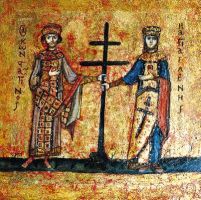Stations of the Cross
Roman Legendary | Scripture Only
History of Stations of the Cross
Pilgrimages to Jerusalem to walk the last steps of our Lord began in the earliest days of the Church. After Constantine's conversion, he persuaded his mother, Helena, to adopt Christianity. At a very advanced age, she made a pilgrimage to Jerusalem to walk the steps of Jesus. Constantine made Sunday a day of worship for all, and Friday a day of devotion. Here is a quotation from Eusebius' History of Constantine.
Constantine and Helena with True Cross
CHAPTER XLII.
That the Empress Helena, (1) Constantine's Mother, having visited this Locality for Devotional Purposes, built these Churches.
For she, having resolved to discharge the duties of pious devotion to the God, the King of kings, and feeling it incumbent on her to render thanksgivings with prayers on behalf both of her own son, now so mighty an emperor, and of his sons, her own grandchildren, the divinely favored Caesars, though now advanced in years, yet gifted with no common degree of wisdom, had hastened with youthful alacrity to survey this venerable land; and at the same time to visit the eastern provinces, cities, and people, with a truly imperial solicitude. As soon, then, as she had rendered due reverence to the ground which the Saviour's feet had trodden, according to the prophetic word which says (2) "Let us worship at the place whereon his feet have stood," she immediately bequeathed the fruit of her piety to future generations. Eusebius: Life of Constantine CHAPTER XLII
"The devotion originated in the late 4th century when pilgrims flocked to the Holy Land from all parts of the world to visit the land of Jesus. Heading the list of places they visited was the Church of the Holy Sepulcher, which had been built by the Emperor Constantine in 335 AD atop Calvary and the tomb of Jesus. " Read more here
We remember these events on the Church calendar with the Feast of the Holy Cross on 14 September, remembering when Helena and her cohort uncovered what they believed to be the cross upon which Jesus was crucified.